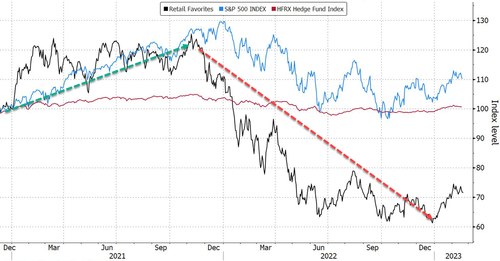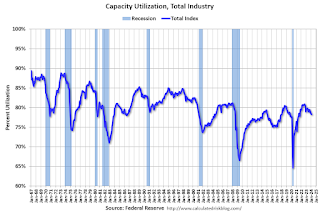Uncategorized
Retail Investors Pour $1.5 Billion Each Day Into US Markets, The “Highest Amount Ever Recorded”
Retail Investors Pour $1.5 Billion Each Day Into US Markets, The "Highest Amount Ever Recorded"
For much of the waning days of 2022, the broader…

For much of the waning days of 2022, the broader theme in markets was a downbeat one, especially for one group of habitual gamblers investors: after a stellar 2021 when nothing made sense and the junkiest of companies exploded higher steamrolling shorts, for retail investors 2022 felt like the polar opposite: a relentless series of gut punches which knocked the air out of basement dwelling daytraders and crushed some of the most popular retail names.
And indeed, a quick search of headlines from mid/late 2022 confirmed that the retail spirit had been broken:
- Did Retail Investors Boost The Broader Market During The "Most Hated Rally" - Aug 2022
- Retail Traders Throw In The Towel - Sept 2022
- Are Retail Investors Done? Biggest Liquidation Since 2020 As Retail Is Now 'Selling The Rally' - Oct 2022
It all culminated with the near record year-end liquidation when in addition to momentum, tax loss selling prompted retail investors to dump single stocks at an unprecedented pace as described Retail Investors Slamming The Bid Amid Tax-Loss Selling Capitulation
However, this record selling flow would not last long, and indeed, just one month later, we wrote that with LO institutions and hedge funds extending their bearish positioning, it was retail investors that picked up the BTFD torch in January, adding that "if retail is once again a more powerful price setter than institutions and hedge funds (thank you zero market liquidity), and we are facing another Jan 2021-type meltup, then watch out above even if none of the abovementioned technicals go into play."
In retrospect we were right, but not even we had any idea just how much we were right.
That's because according to the latest report from retail orderflow specialist Vanda Research, January was a blowout, record month for retail buyers in the market.
As Vanda's Mario Iachini writes, "in the last month, retail investors poured an average of $1.51bn/day into the US markets, the highest amount ever recorded." And as we expected, this group of investors "has continued driving US equity market swings since the second half of last year."
Echoing verbatim our own thoughts, Vanda writes that "with recent surveys showing the institutional investor community remaining broadly bearish on stocks, it would be unwise to underestimate the importance of the retail cohort" as so many bearish hedge funds learned the very hard way in early 2021. "That’s in keeping with retail sales and jobs data for January, suggesting that consumers retain impressive levels of buying power. While the jury is still out on whether that’s due to a robust job market or excess savings from pandemic stimulus, the bottom line is that investors should heed signals from the ‘unsophisticated money’ crowd."
Having said that, seasonality suggests that flows could abate somewhat in the weeks ahead as earnings season falls in the rear-view mirror and investors start preparing for Tax Day in mid-April. However, if broad equity markets continue to perform well, we may instead see flows shifting towards smaller, more speculative companies (this is already occurring to an extent). And while the same could take place in the options market, especially with the dominance of 0DTE option activity, Vanda does not anticipate a repeat of the 2020-21 bubble, given that we are still in the late stages of the economic cycle.
Finally, contrary to popular belief, retail money market funds' net assets at an all-time high suggest that retail investors still have plenty of capital to allocate to riskier investments, provided that market conditions remain supportive.
Vanda discusses this and other related topics in more detail below.
Total net purchases of US securities exceeded expectations by a significant margin on Wednesday. If we only consider periods when the S&P 500 closed in positive territory, Wednesday's aggregate purchases surpassed the previous record set on February 8th. Normally, Vanda would expect this this level of inflows on a day when the S&P 500 experiences a daily decline between -1% and -4%. Instead, "this type of behavior suggests retail traders are FOMO-ing more than any sentiment recent survey would show."
The flipside to the recent retail euphoria is that Vanda expects retail flows into cash equities to decrease in the weeks ahead, as seasonality suggests that March-April are typically middle-of-the-road months during the calendar year.
Furthermore, when looking at a rolling one-month period, inflows have never been higher since the dataset began in 2014 (second chart below). Sustaining such a robust daily pace will prove challenging but it won’t mean the end of the current bull market if institutional investors pick up the slack.
At the same time, and contrary to popular belief (especially among bears), the above doesn’t mean that retail investors are running out of capital to allocate to risky investments. Indeed, from a stock level perspective, the chart below suggests that retail investors have plenty of dry powder in the form of capital parked in money market funds that could be deployed in the equity space once confidence about future market returns increases more broadly.
Adding insult to injury for the institutional bears - of which there is plenty - there is potential for bullish positions to be added in the options market. However, it is uncertain to what extent retail investors are willing to participate in the rally with leverage, given they’re still sitting on significant losses (-25% on average). In any case, nobody expects that the level of speculation observed during the 2020-2021 period will be replicated as we’re still in the later stages of the market cycle. Those dynamics are more likely to take hold during the early recovery phases after a recession has occurred.
The soaring retail investor flows underpin the outperformance of their favorite stocks. A basket of the top 10 most-purchased retail stocks over recent months is experiencing a strong rebound relative to the SPX in 2023. Retail flows have accounted for a +US$18.5bn capital injection YTD in these names (listed below the chart). Should positive momentum in the broad equity market persist, it could push retail investors toward more speculative names, which are more susceptible to such flows given their smaller market cap.
Many smaller-cap single stocks are also beginning to populate the top part of the retail leaderboard so far in 2023. Indeed, the first table below shows that beyond the top 10 most-bought securities, there’s a host of smaller-cap names that have attracted significant inflows this year (~US$2.23bn in total). Moreover, the weighted average performance of this group of stocks is roughly +50%, which is widely outpacing the S&P500 total return of 8.2%.
The other outcome of this dynamic is a pick-up in retail purchases in the ARKK ETF and some of its underlying holdings. It was common back in 2020-21 for retail investors to buy ARK ETFs while at the same time piling in some of their more hyped underlyings. While we don’t expect retail speculation to reach those levels for the reasons discussed above, it is noteworthy that retail investors are vastly outpacing Cathie Wood and Co. regarding purchases across some of these names.
Vanda concludes its weekly retail tracking by pointing out that crypto TradFi proxies are among some of the best performers week-to-date.
Silvergate Capital (SI) shares were up 28.6% at the end of trading Wednesday after Citadel Securities announced that it had taken a stake in the company. Indeed, 13F filings show Citadel Securities bought 5.5% in the digital currency banking company. The shares are up 69% over the past month but remain 91% below their all-time high. With the latest data showing 67% of SI’s shares held short it is likely that retail purchases have helped fuel a short-squeeze over the last three trading days. Given the size of the short book, we wouldn’t be surprised to see retail traders attempt to push the stock further in the coming days, although flows over the past three months show that interest in this name tends to be sporadic and short-lived. In contrast, Coinbase (COIN) seems to enjoy stronger retail tailwinds as bullish activity in the options space is surging as well (second chart).
Finally, here is the aggregate retail flow tracker"
Uncategorized
One city held a mass passport-getting event
A New Orleans congressman organized a way for people to apply for their passports en masse.

While the number of Americans who do not have a passport has dropped steadily from more than 80% in 1990 to just over 50% now, a lack of knowledge around passport requirements still keeps a significant portion of the population away from international travel.
Over the four years that passed since the start of covid-19, passport offices have also been dealing with significant backlog due to the high numbers of people who were looking to get a passport post-pandemic.
Related: Here is why it is (still) taking forever to get a passport
To deal with these concurrent issues, the U.S. State Department recently held a mass passport-getting event in the city of New Orleans. Called the "Passport Acceptance Event," the gathering was held at a local auditorium and invited residents of Louisiana’s 2nd Congressional District to complete a passport application on-site with the help of staff and government workers.
'Come apply for your passport, no appointment is required'
"Hey #LA02," Rep. Troy A. Carter Sr. (D-LA), whose office co-hosted the event alongside the city of New Orleans, wrote to his followers on Instagram (META) . "My office is providing passport services at our #PassportAcceptance event. Come apply for your passport, no appointment is required."
More Travel:
- A new travel term is taking over the internet (and reaching airlines and hotels)
- The 10 best airline stocks to buy now
- Airlines see a new kind of traveler at the front of the plane
The event was held on March 14 from 10 a.m. to 1 p.m. While it was designed for those who are already eligible for U.S. citizenship rather than as a way to help non-citizens with immigration questions, it helped those completing the application for the first time fill out forms and make sure they have the photographs and identity documents they need. The passport offices in New Orleans where one would normally have to bring already-completed forms have also been dealing with lines and would require one to book spots weeks in advance.
These are the countries with the highest-ranking passports in 2024
According to Carter Sr.'s communications team, those who submitted their passport application at the event also received expedited processing of two to three weeks (according to the State Department's website, times for regular processing are currently six to eight weeks).
While Carter Sr.'s office has not released the numbers of people who applied for a passport on March 14, photos from the event show that many took advantage of the opportunity to apply for a passport in a group setting and get expedited processing.
Every couple of months, a new ranking agency puts together a list of the most and least powerful passports in the world based on factors such as visa-free travel and opportunities for cross-border business.
In January, global citizenship and financial advisory firm Arton Capital identified United Arab Emirates as having the most powerful passport in 2024. While the United States topped the list of one such ranking in 2014, worsening relations with a number of countries as well as stricter immigration rules even as other countries have taken strides to create opportunities for investors and digital nomads caused the American passport to slip in recent years.
A UAE passport grants holders visa-free or visa-on-arrival access to 180 of the world’s 198 countries (this calculation includes disputed territories such as Kosovo and Western Sahara) while Americans currently have the same access to 151 countries.
stocks pandemic covid-19 grantsUncategorized
Fast-food chain closes restaurants after Chapter 11 bankruptcy
Several major fast-food chains recently have struggled to keep restaurants open.

Competition in the fast-food space has been brutal as operators deal with inflation, consumers who are worried about the economy and their jobs and, in recent months, the falling cost of eating at home.
Add in that many fast-food chains took on more debt during the covid pandemic and that labor costs are rising, and you have a perfect storm of problems.
It's a situation where Restaurant Brands International (QSR) has suffered as much as any company.
Related: Wendy's menu drops a fan favorite item, adds something new
Three major Burger King franchise operators filed for bankruptcy in 2023, and the chain saw hundreds of stores close. It also saw multiple Popeyes franchisees move into bankruptcy, with dozens of locations closing.
RBI also stepped in and purchased one of its key franchisees.
"Carrols is the largest Burger King franchisee in the United States today, operating 1,022 Burger King restaurants in 23 states that generated approximately $1.8 billion of system sales during the 12 months ended Sept. 30, 2023," RBI said in a news release. Carrols also owns and operates 60 Popeyes restaurants in six states."
The multichain company made the move after two of its large franchisees, Premier Kings and Meridian, saw multiple locations not purchased when they reached auction after Chapter 11 bankruptcy filings. In that case, RBI bought select locations but allowed others to close.
Image source: Chen Jianli/Xinhua via Getty
Another fast-food chain faces bankruptcy problems
Bojangles may not be as big a name as Burger King or Popeye's, but it's a popular chain with more than 800 restaurants in eight states.
"Bojangles is a Carolina-born restaurant chain specializing in craveable Southern chicken, biscuits and tea made fresh daily from real recipes, and with a friendly smile," the chain says on its website. "Founded in 1977 as a single location in Charlotte, our beloved brand continues to grow nationwide."
Like RBI, Bojangles uses a franchise model, which makes it dependent on the financial health of its operators. The company ultimately saw all its Maryland locations close due to the financial situation of one of its franchisees.
Unlike. RBI, Bojangles is not public — it was taken private by Durational Capital Management LP and Jordan Co. in 2018 — which means the company does not disclose its financial information to the public.
That makes it hard to know whether overall softness for the brand contributed to the chain seeing its five Maryland locations after a Chapter 11 bankruptcy filing.
Bojangles has a messy bankruptcy situation
Even though the locations still appear on the Bojangles website, they have been shuttered since late 2023. The locations were operated by Salim Kakakhail and Yavir Akbar Durranni. The partners operated under a variety of LLCs, including ABS Network, according to local news channel WUSA9.
The station reported that the owners face a state investigation over complaints of wage theft and fraudulent W2s. In November Durranni and ABS Network filed for bankruptcy in New Jersey, WUSA9 reported.
"Not only do former employees say these men owe them money, WUSA9 learned the former owners owe the state, too, and have over $69,000 in back property taxes."
Former employees also say that the restaurant would regularly purchase fried chicken from Popeyes and Safeway when it ran out in their stores, the station reported.
Bojangles sent the station a comment on the situation.
"The franchisee is no longer in the Bojangles system," the company said. "However, it is important to note in your coverage that franchisees are independent business owners who are licensed to operate a brand but have autonomy over many aspects of their business, including hiring employees and payroll responsibilities."
Kakakhail and Durranni did not respond to multiple requests for comment from WUSA9.
bankruptcy pandemicUncategorized
Industrial Production Increased 0.1% in February
From the Fed: Industrial Production and Capacity Utilization
Industrial production edged up 0.1 percent in February after declining 0.5 percent in January. In February, the output of manufacturing rose 0.8 percent and the index for mining climbed 2.2 p…

Industrial production edged up 0.1 percent in February after declining 0.5 percent in January. In February, the output of manufacturing rose 0.8 percent and the index for mining climbed 2.2 percent. Both gains partly reflected recoveries from weather-related declines in January. The index for utilities fell 7.5 percent in February because of warmer-than-typical temperatures. At 102.3 percent of its 2017 average, total industrial production in February was 0.2 percent below its year-earlier level. Capacity utilization for the industrial sector remained at 78.3 percent in February, a rate that is 1.3 percentage points below its long-run (1972–2023) average.Click on graph for larger image.
emphasis added
This graph shows Capacity Utilization. This series is up from the record low set in April 2020, and above the level in February 2020 (pre-pandemic).
Capacity utilization at 78.3% is 1.3% below the average from 1972 to 2022. This was below consensus expectations.
Note: y-axis doesn't start at zero to better show the change.
 The second graph shows industrial production since 1967.
The second graph shows industrial production since 1967.Industrial production increased to 102.3. This is above the pre-pandemic level.
Industrial production was above consensus expectations.
-

 Uncategorized3 weeks ago
Uncategorized3 weeks agoAll Of The Elements Are In Place For An Economic Crisis Of Staggering Proportions
-

 International1 week ago
International1 week agoEyePoint poaches medical chief from Apellis; Sandoz CFO, longtime BioNTech exec to retire
-

 Uncategorized4 weeks ago
Uncategorized4 weeks agoCalifornia Counties Could Be Forced To Pay $300 Million To Cover COVID-Era Program
-

 Uncategorized3 weeks ago
Uncategorized3 weeks agoApparel Retailer Express Moving Toward Bankruptcy
-

 Uncategorized4 weeks ago
Uncategorized4 weeks agoIndustrial Production Decreased 0.1% in January
-

 International1 week ago
International1 week agoWalmart launches clever answer to Target’s new membership program
-

 Spread & Containment3 days ago
Spread & Containment3 days agoIFM’s Hat Trick and Reflections On Option-To-Buy M&A
-

 Uncategorized4 weeks ago
Uncategorized4 weeks agoRFK Jr: The Wuhan Cover-Up & The Rise Of The Biowarfare-Industrial Complex

































